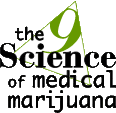This website
sponsored by:
|
Title:
|
Summary of Results of State-sponsored Medical Marijuana Studies | ||
|
Author:
|
Kevin B. Zeese, Esq. |
Date:
|
Nov. 6, 1988 |
|
Summary:
|
Detailed summary of previous studies' findings, by attorney in federal marijuana rescheduling cases | ||
|
Download:
|
Not yet available - check back [get adobe acrobat (PDF) reader] | ||
|
Html:
|
This is a small section taken from a much larger overview. To see the entire overview, go here... | ||
![]() State Health Department Studies
State Health Department Studies
In addition to the published research there have been a series of six studies conducted by state health departments under research protocols approved by the U.S. Food and Drug Administration.The focus of these studies, conducted by six state health agencies was the use of marijuana as an anti-emetic for cancer patients. The studies, conducted in California, Georgia, New Mexico, New York, Michigan and Tennessee, compared marijuana to antiemetics available by prescription, including the synthetic THC pill, Marinol. Marijuana was found to be an effective and safe antiemetic in each of the studies and more effective than other drugs for many patients.
Highlights of the Studies
New Mexico: This study involved 250 patients.The study compared marijuana to THC capsules. The research protocol was approved by the FDA in 1978. In order to participate in the research the patient had to be referred by a physician and had to have failed on at least three other antiemetics. Patients were permitted to choose marijuana or the THC pill.
Both objective (e.g., frequency of vomiting, amount of vomiting, muscle biofeedback, blood samples and patient observation) and subjective measures were made to determine the effectiveness of the drug.
The study concluded that marijuana was not only an effective antiemetic but also far superior to the best available conventional drug, Compazine, and clearly superior to synthetic THC pill." The study found that [m]ore than [90] percent of the patients who received marijuana . . . reported significant or total relief from nausea and vomiting." The study found no major adverse side effects. Only three patients reported adverse reactions, none of these reactions involved marijuana alone. The 1984 report concluded . . . the data accumulated over all five years of the program's operation do show that marijuana smoked resulted in a higher percentage of success than does THC ingested."
California: California conducted a series of studies from 1981 through 1989. Annual reports were submitted to the FDA, state legislature and Governor. Each year approximately 90 to 100 patients received marijuana. The California research was described as a Phase III trial."
The study protocol preferred THC pills by making it much easier for patients to enter that portion of the study. Patients who received marijuana had to be over 15 years of age (the THC pill patients had to be over 5 years of age); had to be marijuana experienced, use the drug on an in-patient basis (patients could only use marijuana in the hospital and not take the medicine home) and had to be receiving rarely used and severe forms of chemotherapy. Thus, the design of the study did not favor marijuana.
Even with this built in bias against marijuana, the study consistently found marijuana to be an effective antiemetic. In 1981 the California Research Advisory Panel reported: "Over 74 percent of the cancer patients treated in the program have reported that marijuana is more effective in relieving their nausea and vomiting than any other drug they have tried." In 1982, a 78.9 percent effectiveness rate was found for smoked marijuana. By 1983 the report was conclusory in its findings stating:
The California Program also has met its research objectives. Marijuana has been shown to be effective for many cancer chemotherapy patients, safe dosage levels have been established and a dosage regimen which minimizes undesirable side effects has been devised and tested.
The California Research Advisory Panel continued to review data on marijuana until 1989 with similar results.
Michigan: The Michigan research compared marijuana to Torecan. It involved 165 patients. Upon admission to the program patients were randomized into control groups with some randomized on the conventional antiemetic Torecan and the remainder randomized to marijuana. When failure on the initial randomized drug occurred, patients could elect to crossover to the alternate therapy. This procedure allowed the Michigan Department of Health to evaluate how well patients responded to both drugs and allowed patients to register their preference.
The Michigan study reported 71.1 percent of the patients who received marijuana reported no emesis to moderate nausea. Ninety percent of the patients receiving marijuana elected to remain on marijuana. Only 8 of 83 patients randomized to marijuana chose to alter their mode of antiemetic therapy. This was almost the inverse of patients randomized to Torecan, there more than 90 percent - 22 out of 23 patients - elected to discontinue use of Torecan and switched to marijuana.
Very few serious side effects were found related to marijuana use. The most common side effect was increased appetite - reported by 32.3 percent of patients - this was a positive effect. The most common negative effects were sleepiness, reported by 21 patients and sore throat, reported by 13 patients.
Tennessee: This study involved an evaluation of 27 patients. The patients had all failed on other forms of antiemetic therapy including oral THC. The study found an overall success rate of 90.4 percent for marijuana inhalation therapy. In comparison it found a 66.7 percent success rate for THC capsules. In the under 40 age group, the study found a 100 percent success rate for marijuana inhalation therapy.
The report concludes:
We found both marijuana smoking and THC capsules to be effective anti-emetics. We found an approximate 23 percent higher success rate among those patients administered THC capsules. We found no significant differences in success rates by age group. We found that the major reason for smoking failure was smoking intolerance; while the major reason for THC capsule failure was nausea and vomiting so severe that patient could not retain the capsule.
New York: In describing the purpose of the marijuana research program the New York Department of Health stated: [t]he program is a large-scale (Phase III) cooperative clinical trial . . . ." The central question addressed is [h]ow effective is inhalation marijuana in preventing nausea and vomiting due to chemotherapy in patients . . . who have failed to respond to previous antiemetic therapy?"
By 1985, the New York program had extended marijuana therapy to 208 patients through 55 practitioners. Of that, 199 patients were evaluated. These patients had received a total of 6,044 NIDA-supplied marijuana cigarettes which were provided to patients during 514 treatment episodes.
In percentage terms the results were stunning:
- North Shore Hospital reported marijuana was effective at reducing emesis 92.9 percent of the time;
- Columbia Memorial Hospital reported efficacy of 89.7 percent;
- Upstate Medical Center, St. Joseph's Hospital and Jamestown General Hospital reported 100 percent of the patients smoking marijuana gained significant benefit.
The report concludes: "Patient evaluations have indicated that approximately ninety-three (93) percent of marijuana inhalation treatment episodes are reported to be effective' or highly effective' when compared to other antiemetics." The New York study reports no serious adverse side effects. No patient receiving marijuana required hospitalization or any other form of medical intervention. See, Evaluation of the Antiemetic Properties of Inhalation Marijuana in Cancer Patients Receiving Chemotherapy Treatment," New York Department of Health, Office of Public Health (Annual Reports).
Georgia: The Georgia program evaluated 119 patients. It compared THC to standardized smoking of marijuana and with patient-controlled smoking. To enter the program a patient had to have failed on other antiemetics. Patients were randomized to either patient-controlled smoking of marijuana, standardized smoking of marijuana or THC pills.
The report found that both THC and marijuana were effective in providing antiemetic relief for patients who were previously unresponsive to antiemetics. The rate of success was 73.1 percent. Patient controlled smoking of marijuana was successful in 72.2 percent, standardized smoking was successful in 65.4 percent and THC was effective in 76 percent of the cases. In comparing the reasons for failure between marijuana and THC the report found:
The primary reasons for failure of THC capsules were due to either adverse reaction (6 out of 18) or failure to improve nausea and vomiting (9 out of 18). The primary reason for failure of smoking marijuana were due to smoking intolerance (6 out of 14) or failure to improve the nausea and vomiting (3 out of 14).

